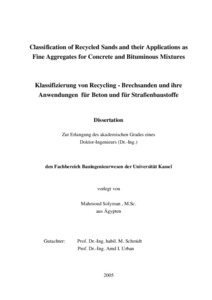| dc.date.accessioned | 2006-05-23T09:54:32Z | |
| dc.date.available | 2006-05-23T09:54:32Z | |
| dc.date.issued | 2005-09-06 | |
| dc.identifier.uri | urn:nbn:de:hebis:34-2818 | |
| dc.identifier.uri | http://hdl.handle.net/123456789/2818 | |
| dc.format.extent | 1561122 bytes | |
| dc.format.mimetype | application/pdf | |
| dc.language.iso | eng | |
| dc.rights | Urheberrechtlich geschützt | |
| dc.rights.uri | https://rightsstatements.org/page/InC/1.0/ | |
| dc.subject | Asphaltbeton | ger |
| dc.subject | Recyclingbeton | ger |
| dc.subject | Recycling in Asphaltbeton | ger |
| dc.subject | Recycled sands | eng |
| dc.subject | Concrete recycling | eng |
| dc.subject | Bituminous mixtures | eng |
| dc.subject.ddc | 620 | |
| dc.title | Classification of recycled sands and their applications as fine aggregates for concrete and bituminous mixtures | eng |
| dc.type | Dissertation | |
| dcterms.abstract | As a result of the drive towards waste-poor world and reserving the non-renewable materials, recycling the construction and demolition materials become very essential. Now reuse of the recycled concrete aggregate more than 4 mm in producing new concrete is allowed but with natural sand a fine aggregate while. While the sand portion that represent about 30\% to 60\% of the crushed demolition materials is disposed off. To perform this research, recycled concrete sand was produced in the laboratory while nine recycled sands produced from construction and demolitions materials and two sands from natural crushed limestone were delivered from three plants. Ten concrete mix designs representing the concrete exposition classes XC1, XC2, XF3 and XF4 according to European standard EN 206 were produced with partial and full replacement of natural sand by the different recycled sands. Bituminous mixtures achieving the requirements of base courses according to Germany standards and both base and binder courses according to Egyptian standards were produced with the recycled sands as a substitution to the natural sands. The mechanical properties and durability of concrete produced with the different recycled sands were investigated and analyzed. Also the volumetric analysis and Marshall test were performed hot bituminous mixtures produced with the recycled sands. According to the effect of replacement the natural sand by the different recycled sands on the concrete compressive strength and durability, the recycled sands were classified into three groups. The maximum allowable recycled sand that can be used in the different concrete exposition class was determined for each group. For the asphalt concrete mixes all the investigated recycled sands can be used in mixes for base and binder courses up to 21\% of the total aggregate mass. | eng |
| dcterms.abstract | Beim Aufbereiten des Bauschutts entsteht je nach verwendetem Brechertyp ein erheblicher Anteil an Brechsand 0 - 4 mm. Untersuchungen haben gezeigt, dass der Anteil bis 2 mm bei ca. 20 - 40 M.-\% und der Anteil 0 - 4 mm zwischen 30 bis 60 M.-\% des aufbereiteten Bauschutts liegt. In die Arbeit wurden 10 RC-Sande von drei unterschiedlichen Recyclinganlagen einbezogen. Diese Sande wurden aus Beton, Beton und Asphaltbeton, Vorabsiebung Bauschutt, Bauschutt, Ziegel und Kalksandstein produziert. Die RC-Sande wurden charakterisiert und als teilweiser oder voller Ersatz des natürlichen Sandes im Beton und im Asphaltbeton verwendet. Für ähnliche RC-Sande kann der Druckfestigkeitsverlust des Betons (cm) Stärke abhängig vom Anteil des RC-Sands und des w/z- Wertes errechnet werden, (siehe Bild 1). Entsprechend der maximalen Menge des RC- Sandes, die im Beton für den Druckfestigkeitsverlust <10\% und 20\% benutzt werden können, werden die RC-Sande in drei Gruppen eingestuft. Die RC-Sande jeder Gruppe werden mit der maximalen Menge des RC-Sandes eingestellt, ohne dass die Dauerhaftigkeit der jeweiligen Expositionsklasse des Betons vermindert wird. Die Hauptaspekt des einflusses der RC-Sande auf die eigenschadten der asphaltbetone wae, dass RC-Samde die Hohlraumgehalt im Mineralgerüst verringeren, die möglicherweise nicht einen genügenden Hohlraum für das wirkungsvolle Bitumen und die erforderlichen Luftporen in der Mischung anbieten. Der volle Ersatz des natürlichen Sandes durch die RC-sande im Asphaltbeton ist in der Tragschichten möglich. | ger |
| dcterms.accessRights | open access | |
| dcterms.alternative | Klassifizierung von Recycling-Brechsanden und ihre Anwendungen für Beton und für Straßenbaustoffe | ger |
| dcterms.creator | Solyman, Mahmoud | |
| dc.contributor.corporatename | Kassel, Universität, FB 14, Bauingenieurwesen | |
| dc.contributor.referee | Schmidt, Michael (Prof. Dr.-Ing. habil.) | |
| dc.contributor.referee | Urban, Arnd I. (Prof. Dr.-Ing.) | |
| dc.subject.swd | Recycling | ger |
| dc.subject.swd | Brechsand | ger |
| dc.subject.swd | Beton | ger |
| dc.subject.swd | Strassenbaustoff | ger |
| dc.date.examination | 2005-07-12 | |

